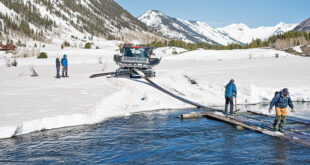Trying to change forest health practices
[ By Katherine Nettles ]
To most people, the concept of “living with wildfires” is an alarming prospect. Yet as the Western United States braces for another high summer season of drought and wildfires, local fire experts are trying to prepare residents for what seems inevitable for a wildland-urban interfacing community like Crested Butte and its surrounding area. The Crested Butte Fire Protection District (CBFPD) hosted an evening of education in wildfire prevention and awareness at the Center for the Arts on April 27, which included a movie and a panel discussion that put emerging trends into a larger perspective. According to these experts, living with wildfire on a smaller scale might be the key to avoiding the mega fires becoming more common across the West.
Gunnison County is updating its wildfire prevention and response plans, and held a wildfire risk and reduction meeting in March to discuss potential policy changes like new building code amendments and risk mapping. Then at the April event the CBFPD screened the film Era of Megafires with research ecologist Dr. Paul Hessberg and held a panel discussion with their own fire chief Rob Weisbaum and members of the West Region Wildfire Council, Colorado State Forest Service, Gunnison County Emergency Management department and community development department, Gunnison Fire Protection District, the U.S. Forest Service and the Bureau of Land Management.
Era of Megafires traces the human history of living with smaller, intermittent wildfires until the 19th century, when tragic loss of life prompted an era of fire suppression policies. While those policies were successful for many decades, Hessberg demonstrates that they have ultimately led to a bigger problem where dense, homogenous forests are not accustomed to periodic fires and go bigger than ever before when their time comes. Add in droughts, warmer temperatures and continued development within the wildland-urban interface, and mega fires, defined as fires burning more than 100,000 acres, have increased at an alarming rate even since the film was produced in 2018.
Dr. Hessberg describes how to recreate more resilient landscapes and reduce their destruction by allowing smaller recurring fires back into the landscape while managing other hazards better.
“This is not just up to public land managers and firefighters. This is a social problem,” says Hessberg. “In the end we can learn to live with wildfires in a completely different way.”
“Five is not enough”
The panel discussion after the film involved local and regional experts discussing the reality of living with wildfires and what that means. The answer appears to be many different tactics. The Colorado Division of Fire Prevention and Control anticipates warmer than average temperatures and below average precipitation into June on the Western Slope, and those conditions persisting into July for the Front Range. If that is the reality, drought conditions across the state will worsen and significant wildfire potential will threaten large areas.
Jamie Gomez, executive director for the West Region Fire Council, described how there are generally five firefighters on duty each day in the 220 square miles of the CBFPD that includes Crested Butte, Mt. Crested Butte, Irwin, CB South, Gothic and all areas in between. “Five is not enough,” he said, to combat a wildfire in the area before it becomes potentially destructive.
Chief Weisbaum said that in recent years his staff have been able to get on four to five large fires around the West which is helpful for their experience and preparation. “We are also investing in more wildland fire trucks,” he said.
However, all panelists seemed to agree that the most important steps to take beyond firefighters and fire trucks would be better forest management, including thinning areas, creating large fire break areas, doing more and larger prescribed burns and preparing homeowners to protect their homes and their communities with defensible space and home hardening. Home hardening is either building with fire resistant materials or retrofitting in key ways to prevent embers from catching fire in a building.
Cathie Pagano, Gunnison County assistant county manager for community and economic development, described how residents can aim for “lean, mean and green” vegetation around the perimeter of their homes, and other panelists described efforts to reduce invasive weeds that increase fire danger, how logging certain areas is on the horizon, how residents can request a site visit to get a professional opinion on their home’s defensibility and how wet meadow restoration can increase an area’s resilience by holding moisture.
Finally, Gunnison County Emergency Management director Scott Morrill and a representative from the BLM described how people can sign up for CODE RED alerts (on the county website or at public.coderedweb.com/CNE/en-US/BF7ED953CC69) and how the county is working to prepare for a response by mapping out high danger areas, water sources and safe zones for firefighters. This includes determining potential exit areas to get people out of an area safely and being informed about where mitigation is happening and needs to happen in the future. More than one panelist said Trappers Crossing is at particularly high fire risk at present, and that there need to be measures to address it sooner than later.
“It takes a community, it’s not just one agency,” Gomez concluded.
May is Wildfire Awareness Month, and for more information about reducing wildfire risk, search for the hashtag #COWildfireAware on Twitter and Facebook, or visit bit.ly/COWildfireMitigation.
 The Crested Butte News Serving the Gunnison Valley since 1999
The Crested Butte News Serving the Gunnison Valley since 1999




